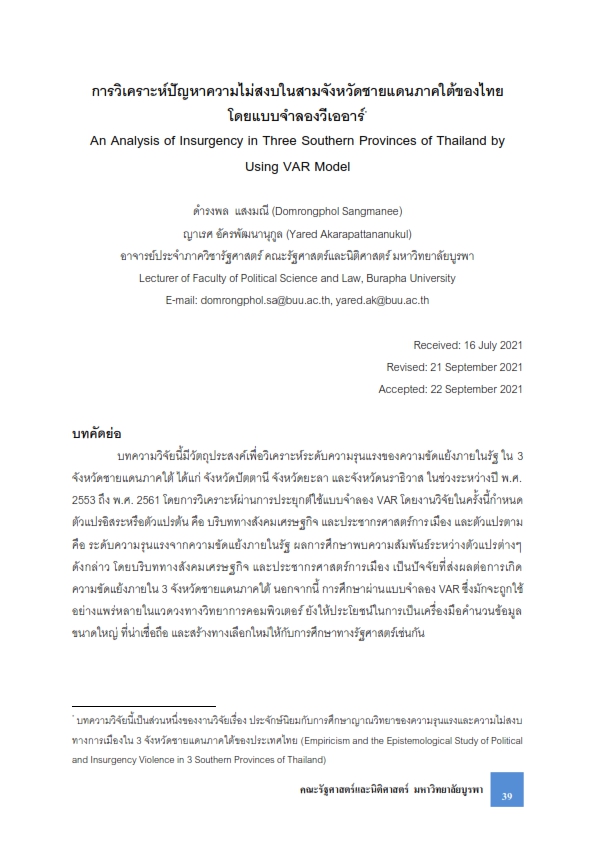An Analysis of Insurgency in Three Southern Provinces of Thailand by Using VAR Model
Thai
Keywords:
Insurgency, Intrastate Conflict, VAR Model, Three Southern Provinces of ThailandAbstract
This study aims to analyze the level of violence from intrastate conflict in three southern provinces of Thailand – Pattani province, Yala province and Narathiwat province - during 2010 – 2018 by applying VAR Model. The research addresses two groups of variables including independent and dependent variables, employing the socio-economic conditions and political demographic structures as independent variables and the numbers of violence from intrastate conflict as a dependent variable. The research found the relationship amongst these variables. That is to say, the socio-economic and political demographic conditions are sufficient to play a role as factors that trigger the intrastate conflict in these three southern provinces. In addition, the practice of VAR model, which is previously used in the field of computer science, sheds light on the analytical reliability of big data and provides an alternative way to the study of politics in this study.
References
Abuza, Z. (2011). The Ongoing Insurgency in Southern Thailand Trends in Violence, Counterinsurgency Operations, and the Impact of National Politics’. Washington, D.C.: National Defense University Press.
Bagozzi, B. E. (2015). Forecasting Civil Conflict with Zero-Inflated Count Models. Civil Wars, 17(1), 1-24.
Berman, E., & Laitin, D. D. (2008). Religion, Terrorism and Public Goods: Testing the Club Model’. Journal of Public Economics, 92(10), 1942-1967.
Berman, E., & Matanock, A. M. (2015). ‘The Empiricists' Insurgency’. Annual Review of Political Science, 18(1), 443-464.
Brandt, P. T., Freeman, J. R., & Schrodt, P. A. (2011). Real Time, Time Series Forecasting of Inter- and Intra-State Political Conflict. Conflict Management and Peace Science, 28(1), 41-64.
Chou, T. (2012). Does Development Assistance Reduce Violence? Evidence from Afghanistan. Economics of Peace and Security Journal, 7(2), 5-13.
Cincotta, R. (2011). Minority Youth Bulges and the Future of Intrastate Conflict. Retrieved January 19, 2021, from http://politicaldemography.org/wpcontent/uploads/2017/ 03/NSB_Cincotta_Minority_YB.pdf
Cincotta, R. (2015). Demography as Early Warning: Gauging Future Political Transitions in the Age-structural Time Domain. Journal of Intelligence and Analysis, 22(2), 129-148.
Deep South Incident Database (DSID). (2017). Deep South Watch Database. Retrieved September 21, 2021, from https://www.deepsouthwatch.org/node/11471
Deep South Watch. (2016). ฐานข้อมูล DSID: การวิเคราะห์ข้อมูลเหตุการณ์ความไม่สงบในพื้นที่จังหวัด ชายแดนภาคใต้ในรอบปี 2558. Retrieved January 19, 2021, from https://deepsouthwatch.org/node/7942
Forsberg, E. (2008). Polarization and Ethnic Conflict in a Widened Strategic Setting. Journal of Peace Research, 45(2), 283-300.
Freytag, A., Krüger, J. J., Meierrieks, D., & Schneider, F. (2011). The Origins of Terrorism: Cross-Country Estimates of Socio-economic Determinants of Terrorism. European Journal of Political Economy, 27(Supplement 1), 5-16.
Gurr, T. R. (1971). Why Men Rebel. Princeton, N.J.: Princeton University Press.
Hammond, J., & Weidmann, N. B. (2014). Using Machine-coded Event Data for the Micro-level Study of Political Violence. Research & Politics, 1(2). 1-8.
Iannaccone, L. R., & Berman, E. (2006). Religious Extremism: The Good, the Bad, and the Deadly. Public Choice, 128(1), 109-129.
Jitpiromsri, S., & McCargo, D. (2010). The Southern Thai Conflict Six Years On: Insurgency, Not Just Crime. Contemporary Southeast Asia: A Journal of International and Strategic Affairs, 32(2), 156-183.
Krieger, T., & Meierrieks, D. (2011). What Causes Terrorism?. Public Choice, 147(1/2), 3-27.
Kugler, J., & Lemke, D. (1996). Parity and War: Evaluations and Extensions of The War Ledger. Ann Arbor: Michigan University Press.
Mahoney, S. M., Comstock, E., deBlois, B., & Darcy, S. (2011, May 18, 2011 – May 20, 2011). ‘Aggregating Forecasts Using a Learned Bayesian Network’. Paper presented at the Twenty-Fourth International FLAIRS Conference, Palm Beach, Florida, USA.
McCargo, D. (2004). Southern Thai politics: A preliminary overview. (POLIS Working Paper No. 3). POLIS.
National Statistical Office. (2019). Retrieved September 21, 2021, from http://www.nso.go.th/sites/2014/Pages/home.aspx
Pfaff, B. (2008). Analysis of Integrated and Cointegrated Time Series with R. Seattle: Springer.
Reed, W. (2000). A Unified Statistical Model of Conflict Onset and Escalation. American Journal of Political Science, 44(1), 84-93.
Sambanis, N., & Shayo, M. (2013). Social Identification and Ethnic Conflict. American Political Science Review, 107(02), 294-325.
Somboonsuke, B., Phitthayaphinan, P., & Kongmane, C. (2018). Para-rubber Policies with Pararubber Plantations: Implication from the Three Southern Border Provinces. Journal of Humanity and Social Science, Mahasarakham University, 37(5), 96.
Srisompob, J., & Panyasak, S. (2006). Unpacking Thailand's Southern Conflict: The Poverty of Structural Explanations. Critical Asian Studies, 38(1), 95-117.
Ward, M. D. B. (2005). Predicting Civil Conflicts: on the Utility of Empirical Research. Conference on Disaggregating the Study of Civil War and Transnational Violence, University of California Institute of Global Conflict and Cooperation, San Diego.
Wheeler, M. (2014). Thailand’s Southern Insurgency. Southeast Asian Affairs, 319-335.






